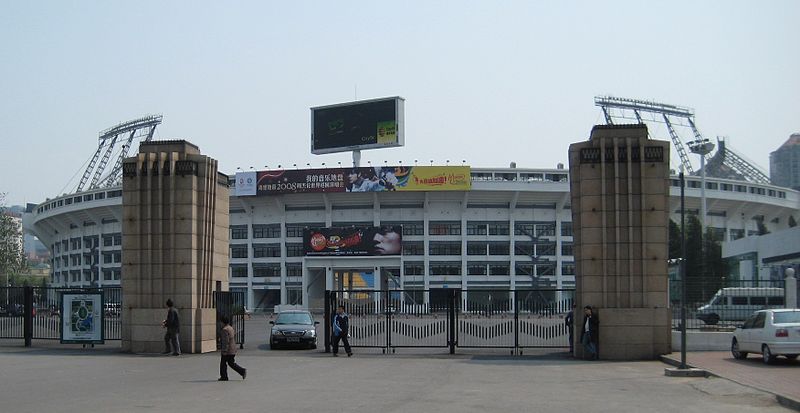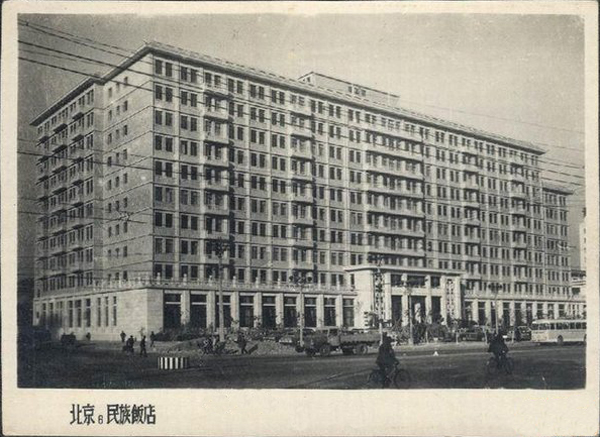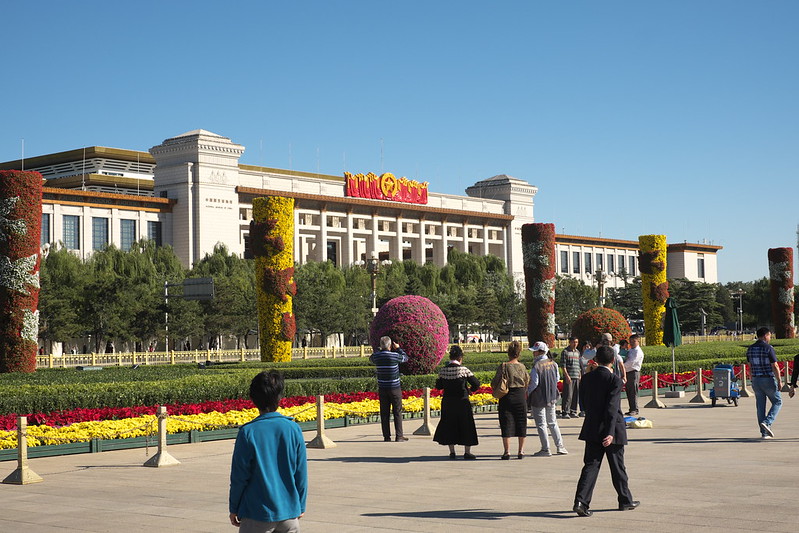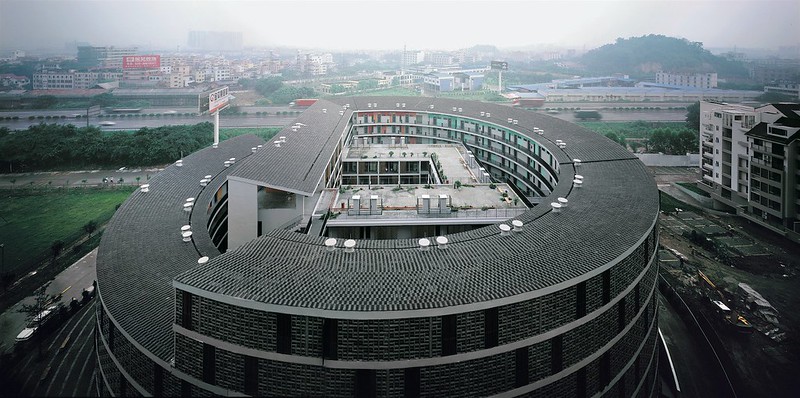Chinese brutalism
Contents |
[edit] Introduction
Brutalism is a style of architecture that grew out of the early-20th century modernist movement. Brutalist buildings are characterised by their massive, monolithic and ‘blocky’ appearance with a rigid geometric style and large-scale use of poured concrete.
Chinese brutalism is defined by a solid, severe aesthetic that emphasises utilitarian functionality. Like its counterparts around the world, Chinese brutalism uses concrete as one of its primary building materials.
[edit] The first wave of Chinese brutalism
The brutalist architectural style first appeared in China after the People's Republic of China was formed in 1949. During this period, the country experienced an increased demand for utilitarian structures designed to support housing and manufacturing requirements.
The early Chinese brutalism was synonymous with socially-progressive housing solutions that architects and town planners promoted as modern ‘streets in the sky’.This approach combined the ethos of ‘social utopianism’ with the influence of constructivist architecture.
Stylistically, urban planning took direction from the Soviet approach to brutalism, incorporating grand squares as central gathering points.
[edit] The 10 Great Buildings
In 1959, the People’s Republic of China celebrated the 10th anniversary of its founding. As part of this tribute, the country took its 'Great Leap Forward' - a cultural initiative that highlighted architecture and urban planning. Included in the initiative were projects that blended Socialist Realism and International Modernism with touches of traditional Chinese design. This Great Leap Forward included construction of the 10 Great Buildings.
Of the 10 Great Buildings, six incorporated principles of Stalinist architecture through the lens of Chinese brutalism. These buildings are:
- The Workers’ Stadium (renovated in 2004).
- The Minzu Hotel.
- The Overseas Chinese Hotel (demolished in the 1990s).
- The Great Hall of the People.
- The National Museum of China.
- The Chinese People's Revolutionary Military Museum.
Minzu Hotel
National Museum of China
The other four buildings - the Cultural Palace of Nationalities, the Beijing railway station, the National Agriculture Exhibition Hall and the Diaoyutai State Guesthouse - have different design motifs.
Most of the buildings were constructed in the 10 months leading up to the 10th anniversary. The work was undertaken through a collaborative effort of the Beijing Institute of Architectural Design, the Beijing Planning Bureau and the Ministry of Construction. To commemorate the significance of the 10 year milestone, two of the buildings (the Great Hall of the People and the National Museum of China) incorporated the number 10 into design elements as well.
For more information see: 10 great buildings.
[edit] Maoist era Chinese brutalism
During the Maoist era, Chinese brutalism was commonly used for government projects, universities, car parks, leisure and shopping centres and high-rise blocks of flats.
Examples of Maoist-era Chinese brutalism include:
[edit] Modern Chinese brutalism
China’s production of concrete has helped sustain the Chinese brutalist style in recent years. China is one of the largest consumers of cement and concrete with Chinese architects generously incorporating the material into infrastructure and building projects throughout the country.
Modern Chinese brutalism is still characterised by its rough, unfinished surfaces, unusual shapes, heavy materials, straight lines and small windows. As well as concrete, other materials commonly used in Chinese brutalist buildings include brick, glass, steel and rough-hewn stone.
Examples of modern Chinese brutalism include:
- Taizhou Contemporary Art Museum (Architect: Atelier Deshaus).
- Gymnasium of New Campus of Tianjin University (Architect: Atelier Li Xinggang).
- Ningbo History Museum (Architect: Amateur Architecture Studio).
- Luyeyuan Ston Sculpture Art Museum (Architect: Jiakun Architects).
- Memorial Hall of Long March of the Red Army (Architect: Atelier FCJZ).
- Seashore Library (Architect: Vector Architects).
- Lippo Centre (Architect: Paul Rudolph).
- Urban Tulou (Architect: Urbanus).
- Xiangshan Campus (Architect: Wang Shu/Amateur Architecture).
- Hangzhou Arts Academy Campus (Architect: Wang Shu/Amateur Architecture).
Urban Tulou
[edit] Related articles on Designing Buildings Wiki
- 10 great buildings.
- Architectural styles.
- Beijing National Stadium.
- Brutalism.
- Chinese renaissance architecture in China and Hong Kong.
- Chinese wall.
- Chinese Wallpaper in Britain and Ireland.
- Concrete.
- Deconstructivism.
- Duplitecture.
- Feng shui.
- Heroic architecture.
- International style.
- Modernism.
- New Chinese approach to masterplan designs.
- Spanish brutalism.
- The Chinese construction industry.
Featured articles and news
Government consultations for the summer of 2025
A year of Labour, past and present consultations on the environment, the built environment, training and tax.
CMA competitiveness probe of major housing developers
100 million affordable housing contributions committed with further consultation published.
Homes England supports Greencore Homes
42 new build affordable sustainable homes in Oxfordshire.
Zero carbon social housing: unlocking brownfield potential
Seven ZEDpod strategies for brownfield housing success.
CIOB report; a blueprint for SDGs and the built environment
Pairing the Sustainable Development Goals with projects.
Types, tests, standards and fires relating to external cladding
Brief descriptions with an extensive list of fires for review.
Latest Build UK Building Safety Regime explainer published
Key elements in one short, now updated document.
UKGBC launch the UK Climate Resilience Roadmap
First guidance of its kind on direct climate impacts for the built environment and how it can adapt.
CLC Health, Safety and Wellbeing Strategy 2025
Launched by the Minister for Industry to look at fatalities on site, improving mental health and other issues.
One of the most impressive Victorian architects. Book review.
Common Assessment Standard now with building safety
New CAS update now includes mandatory building safety questions.
RTPI leader to become new CIOB Chief Executive Officer
Dr Victoria Hills MRTPI, FICE to take over after Caroline Gumble’s departure.
Social and affordable housing, a long term plan for delivery
The “Delivering a Decade of Renewal for Social and Affordable Housing” strategy sets out future path.
A change to adoptive architecture
Effects of global weather warming on architectural detailing, material choice and human interaction.
The proposed publicly owned and backed subsidiary of Homes England, to facilitate new homes.
How big is the problem and what can we do to mitigate the effects?
Overheating guidance and tools for building designers
A number of cool guides to help with the heat.
The UK's Modern Industrial Strategy: A 10 year plan
Previous consultation criticism, current key elements and general support with some persisting reservations.
Building Safety Regulator reforms
New roles, new staff and a new fast track service pave the way for a single construction regulator.




























